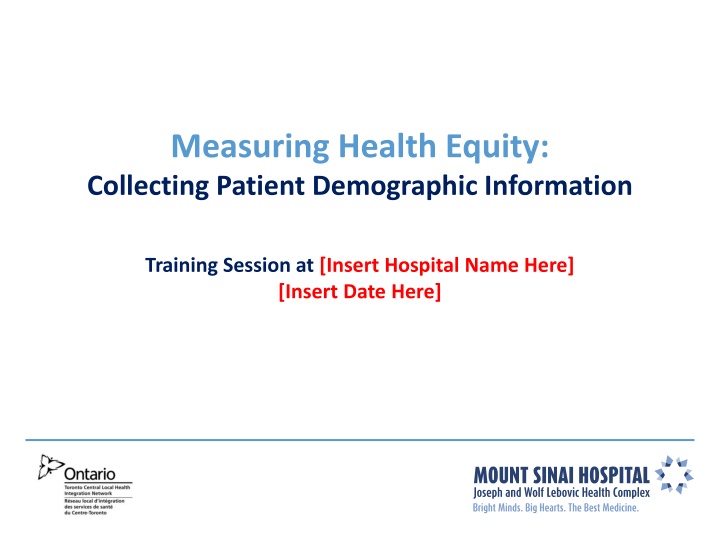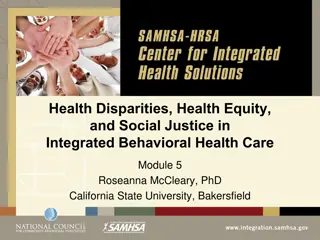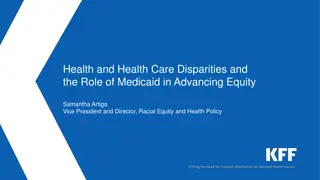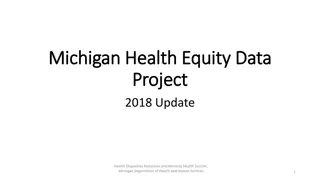Measuring Health Equity Training Session
"Join us at [Insert Hospital Name Here] for a training session on collecting patient demographic information to promote health equity. Explore the importance of data collection, learn to administer questionnaires sensitively, and understand the principles of group work. Gain insights into health statistics and the mandate for data collection in the Toronto Central LHIN. Enhance your ability to define health equity, communicate with patients, and contribute to equitable healthcare practices."
Download Presentation

Please find below an Image/Link to download the presentation.
The content on the website is provided AS IS for your information and personal use only. It may not be sold, licensed, or shared on other websites without obtaining consent from the author.If you encounter any issues during the download, it is possible that the publisher has removed the file from their server.
You are allowed to download the files provided on this website for personal or commercial use, subject to the condition that they are used lawfully. All files are the property of their respective owners.
The content on the website is provided AS IS for your information and personal use only. It may not be sold, licensed, or shared on other websites without obtaining consent from the author.
E N D
Presentation Transcript
Measuring Health Equity: Collecting Patient Demographic Information Training Session at [Insert Hospital Name Here] [Insert Date Here]
Agenda Introduction & Ground Rules Health Equity Statistics Exercise Demographic Data Collection: What we know How to ask and answer questions Data collection at [Insert hospital name here] Videos and Practice Session Your questions Next Steps & Evaluation Your chance to participate!
Learning Outcomes At the end of today s session you ll be able to: Define health equity Tell patients why hospitals need to collect demographic data Explain the 8 questions Administer the questionnaire in a sensitive, respectful way
Principles of group work Listen carefully while others are speaking Speak from one s own experience- e.g. I think rather than everyone knows No personal attacks- challenge the perspective, not the individual Try not to blame- look for solutions that group members can act on Discuss issues that are raised in the training in the training Ask for clarification from group members or the facilitators, when needed Put devices on silent function. Use respectful etiquette
Statistics Activity Learning about health inequities Please walk around the room, read the statistics on the wall, and then stand beside the group of statistics that most affects, surprises or interests you We will then spend a few minutes sharing
Background: Measuring Health Equity in the TC LHIN As part of its Health Equity focus, the Toronto Central LHIN mandated that all TC LHIN should start collecting patient demographic information Hospital Service Accountability Agreement 2013-4: 5. Continue to actively support TC LHIN health equity initiatives with the expectation that HSPs participate in the implementation of related initiatives, including collection of socio-demographic data.
What is health equity? Equity in health care refers to ensuring quality care and best outcomes regardless of race, religion, language, income or any other individual characteristic. Safe Quality care Effective Patient-centered Timely Efficient Equitable
Commitment to Health Equity Best practices in health equity: Collect patient-level demographic data Use patient data to address patient needs Identify and report inequities in care Implement solutions to reduce inequities
Asking patients for information Be mindful of barriers around language and literacy Some patients are likely to have experienced discrimination and harassment and may be reluctant to answer questions State that answering the questions is entirely voluntary and that they can say prefer not to answer or do not know for all items Explain all patients are being asked these questions, and that like all health care information, answers will remain confidential All this is research and evidence-based. Share that!
What do we know about demographic data collection in Toronto About patients: Patients are willing to share this information Two most frequent questions are: Why are collecting this information? And Who can see this information? About staff: Staff comfort increases with practice Increased familiarity with questions decreases time needed to collect demographic information Best practice: Face-to-face interaction in data collection
Quick Guide to Collecting Demographic Data Introduce yourself Explain the purpose of the demographic data collection* Explain what will happen to the data: Who is this visible to? This information may also be used by researchers, only it will be grouped with information from other patients with no name or personal identifiers. (i.e. it can t be traced back to a single individual) Our hospital has started collecting patient information to help us for services and provide quality care * Use available resources (brochure, poster, )
Quick Guide to Collecting Demographic Data Suggested message to patient: This will take a few minutes It s completely voluntary, so you can choose prefer not to answer to any of questions. These questions will tell us who our patients are
Data Collection: Purpose in 3 steps It s all about quality care Find out who our patients are Plan and deliver tailored care Ensure best outcomes for all
8 TC LHIN Items: What they mean, why they re important LANGUAGE To provide appropriate care delivery as required by the Charter of Rights and Freedoms To acquire informed consent To improve access to care for those who do not speak/ready English or French Use of interpreters and translators has direct impact on quality and safety Uses in care Uses in planning Impact on quality
BORN IN CANADA To address barriers and stress associated with migration and settlement To understand the types of supports or services needed Improve access to care for newcomers to Canada Uses in care Uses in planning Impact on quality
RACIAL/ETHNIC GROUP To provide targeted care and supports (e.g. Middle Eastern populations & thalassemia, ) To improve outreach to vulnerable groups who do not seek care at the same level as other groups To address access challenges Outreach improves preventative care and reduces admissions Uses in care Uses in planning Impact on quality
DISABILITY To fulfill hospital responsibilities around providing accommodation Address histories of traumatic interactions Uses in care To carry out accommodation planning To work on preventing recurrence of exclusion Uses in planning Better accommodation leads to more efficient and effective care Impact on quality
GENDER Both sex and gender are relevant to room assignment and other essential medical testing To accommodate the unique needs related to patients gender identity To improve outreach to vulnerable groups who do not access care at the same level as other groups Outreach better planning improves preventative care and health outcomes Uses in care Uses in planning Impact on quality
SEXUAL ORIENTATION To understand the needs of patients (e.g. living with discrimination) To create welcoming environments for LGB community members To identify LGB friendly community partners Providing a welcoming environment improves access and patient experiences Uses in care Uses in planning Impact on quality
INCOME person(s) Relevant for discharge planning Relevant for medical prescriptions Uses in care To ameliorate the impact of income on access to primary and preventative health-care Uses in planning Improved health-care for all Impact on quality
Training Manual & Support Glossary (p. 30) Responding to Patients Questions (p. 25) Quick Answers to Frequently Asked Questions (p. 28)
Best Practices in Demographic Data Collection
Question-based video clips What did you see happening? Disability Gender Identity How do you evaluate the admitting clerk s interaction with the patient? Race & Religion Income What did the interviewer specifically say or do that encouraged the patient to answer the questions?
Practice session Form groups of 3: Patient, Staff, Observer Review practice exercise Questions: How well does the staff person explain the questions? What was done well? Can anything be improved? What advice do you have for the staff member?
Wrap-up Your input, Evaluation, Questions?























